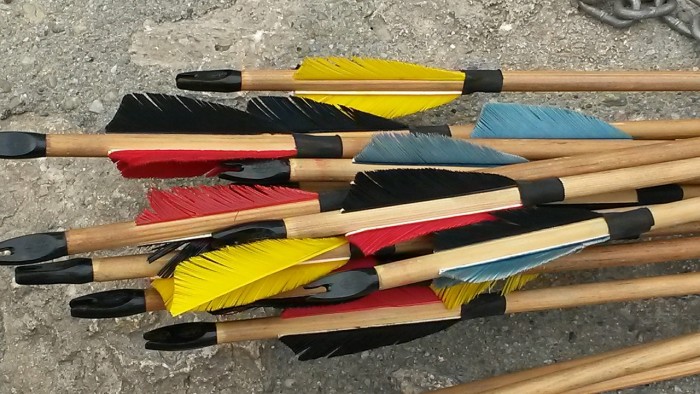What is Fletching?
Near to the rear of an arrow, there are three feathers or plastic vanes – two of one colour, and the other in a contrasting colour – collectively called the fletching. The purpose of the fletching is stability. When all is going to plan, and the arrow is flying in a perfectly straight line, the fletches will slice through the air without changing the course of the arrow. If, on the other hand, the arrow is wobbling, and its tail is not perfectly following its tip, it will be brought back into line and stabilised, due to friction between the fletching and the air.

For centuries, fletching was made of feathers – after all, they’re nature’s own design, and they obviously work. Despite enormous leaps forward in technological design, feathers are still contenders in a ‘Who’s best?’ contest. In fact, even the new kid on the block, the compound bow, is sometimes spotted shooting arrows with feather fletching.
Understanding the Structure of a Flight
The rigid structure of interlocking barbs and hooks in a primary flight feather is due to a protein called keratin, which allows the feather to retain its shape when wet. Although the right kind of feather will not be ruined by getting wet, it will, nevertheless, be heavier with the added weight of water. But if you’re set on using feather fletching, you can use a waterproofing powder, designed specifically for this purpose.
The rough, latticed surface of a natural feather is second to none when it comes to creating friction with air, and this is a big attribute when it comes to stabilisation. And despite amazing advancements in the science of synthetic materials, no plastic vane is anywhere near as lightweight as a feather.
If you want to learn more about the things to look for when buying archery items, check out our Buyers Guide to Archery for Newbies, or the Buyers Guide to Archery for Pros.
Feather versus Plastic
 However, the most popular choice of fletching for today’s archer is the inexpensive, durable, waterproof plastic vane. Available in a seemingly endless range of colour and size, these soft, flexible vanes can be easily applied in whichever formation you prefer. Even after a fair amount of rough treatment, they’ll pop back into shape; and if they become really warped, you can usually get them back into shape with a bit of heat treatment – a hair drier is the best thing to use.
However, the most popular choice of fletching for today’s archer is the inexpensive, durable, waterproof plastic vane. Available in a seemingly endless range of colour and size, these soft, flexible vanes can be easily applied in whichever formation you prefer. Even after a fair amount of rough treatment, they’ll pop back into shape; and if they become really warped, you can usually get them back into shape with a bit of heat treatment – a hair drier is the best thing to use.
If you choose plastic vane fletching, you must also make a decision about the angle (or turn) of the fletch on the arrow shaft. Will your priority be speed, or accuracy? Will your choice be restricted by the design of your bow?
A straight fletch is affixed to the shaft in a perfectly straight position, running parallel with the shaft itself. The vane slices through the air, causing minimal friction, and therefore no loss of speed. However, because straight fletching prevents the arrow from spinning, the arrow can become unstable and less able to right itself. This disadvantage becomes more significant the further you have to shoot.
The helical fletch is attached to the arrow’s shaft at an angle, and the fletch itself is also curved, creating maximum wind resistance, and therefore plenty of spin. This spin will help to stabilise your arrow in the same way that a pellet is stabilised by the rifling effect of an airgun. Stability, of course, leads to improved accuracy, but the large amount of friction that causes this fast spin will slow your arrow down.

Which Flies Better – Helical or Straight?
The helical formation is really the only option for feather fletching, as it’s just about impossible to force the naturally curved feather into a straight line. Helical fletching is also ideal for bows of low draw weight. With less speed, there is less stability, so the more spin you can get, the better.
But is there a middle road between the straight and the helical fletch? Yes, there is! It’s the offset fletch.
The offset fletch is straight, but it’s turned at an angle on the arrow shaft. This is an effective solution in cases where the arrow rest doesn’t provide enough clearance for helical fletching to pass through. Contact between the arrow rest and the fletching will compromise speed and stability.
In the case of helical or offset fletching, which way should the arrow spin? The answer is, in general, clockwise – to the right, as you look at the arrow from the nock. It’s all to do with the thread of the tip. When the arrow enters the target counter-clockwise, the tip will unscrew; when it goes in clockwise, it will tighten.
To ensure a clockwise spin, make sure that the upper end of the fletch (the end closest to the tip) is offset to the right as you look down on the arrow from the nock end.
Does Size Matter?
Now, what about size? Does it matter? Well, yes, it does.
When shooting over long distances – 100 meters or more – you’ll do well to use fletches of at least 4” long. The further your arrow travels, the more vulnerable it is to instability. Therefore, every bit of surface area in your fletching will count. Whether you choose to use straight, offset, or helical fletching will depend on other variables in your equipment and environment.
Check out our wide range of arrows and bolts, or you can have a read of How to Become a Competitive Archer on our blog

